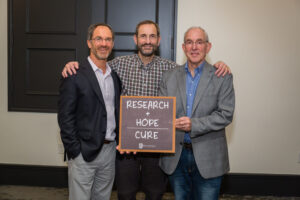Dystonia Coalition Natural History Study Sheds Light on Dystonia Symptom Spread

This article was originally published in the Dystonia Dialogue.
The Dystonia Coalition is a global research network funded by the National Institutes of Health that has engaged investigators and patients on an unprecedented scale to improve dystonia treatment. Since 2010, the Dystonia Coalition has included a Natural History of Isolated Dystonia study aimed at better understanding how dystonia may progress over time and the underlying causes.
Does dystonia change over time? What genes might be involved in the development of dystonia? How often does dystonia disappear, and does it come back? How does dystonia impact quality of life? These are the types of questions the Natural History of Isolated Dystonia study seeks to answer.
“We want to figure out what happens overtime when there’s not any interventions or treatment, so that we can understand the typical course of the disorder. It’s really important to understand that thoroughly if we want to be able to test new treatments,” explained Dystonia Coalition Co-Director and DMRF Scientific Director Joel S. Perlmutter, MD, who is the Elliot Stein Family Professor of Neurology, Professor of Radiology, Neuroscience, Occupational Therapy and Physical Therapy, and Head of Movement Disorders at Washington University in St Louis.
Investigator-Patient Partnership
The Natural History of Isolated Dystonia aims to recruit large numbers of dystonia patients and study their long-term dystonia experience. To date, more than 3,200 volunteers with dystonia have participated from all over the world—North America, Europe, the Middle East, Asia, and Australia. One of the biggest upfront challenges to a project of this kind is locating and engaging dystonia patients, and not only those who have regular contact with movement disorder clinics. Patients who regularly visit movement disorder clinics for treatment with botulinum injections and tend to be those who respond well to treatment, can skew the data by not fully representing the patient population. Another challenge is retaining patients over the years for follow up study visits. “A very important way of retaining participants in these kinds of studies is to report back to them what we’ve been learning,” explained Dr. Perlmutter, “so the participants are enfranchised. Clearly they are the critical part of the research team, but it’s important to make them feel like they’re part of the research team.”
Discoveries & Impact
Dystonia Coalition studies have resulted in more than 100 study publications in the medical literature,an impressive measure of the discoveries and advancements being made. “This large number of publications demonstrates the substantial progress in understanding the natural history of these types of dystonia,” said Dr. Perlmutter. One of the critically important areas of focus is understanding how and when dystonia progresses. Dystonia symptoms typically begin in one part of the body and may spread to other body areas. This is seen most dramatically in childhood onset dystonias, which may ultimately affect many parts of the body and particularly the limbs. Symptom spread is a possibility in adults, though the frequency and patterns are less well documented.
Scott Norris, MD, who trained with Dr. Perlmutter, led a study to examine the risk of symptom spread in cervical dystonia. Dr. Norris is a past DMRF clinical fellow and current grantee,who has devoted much of his career to studying dystonia and treating patients. Understanding the frequency with which cervical dystonia may spread and patterns of spread is essential for developing strategies to minimize or prevent progression.Previous studies to understand spread in dystonia have tended to be small studies from individual clinics that examined data in retrospect. The Natural History of Isolated Dystonia study collects data prospectively, in real time, at multiple movement disorder clinics around the world. Looking at more than 1,400 cervical dystonia patients, Dr. Norris’ analysis demonstrated that in approximately 80% of cases, focal dystonia that begins in the neck will not spread to other body areas. Spread to other body areas did occur in approximately 20% of cases,most often to the hand, facial muscles, and voice box. The natural history data was also analyzed to examine what adult onset focal dystonias were most likely to spread, and in what patterns. An investigation led by Brian Berman, MD examined nearly 500 volunteers with blepharospasm, cervical dystonia, hand dystonia, and laryngeal dystonia (spasmodic dysphonia). The study found that the body area where symptoms begin strongly predicts both the risk of spread and the body areas to which symptoms spread. Patients with blepharospasm experienced spread in 50% of cases, which is much more frequently than those with cervical (9%), hand(17%), or laryngeal (16%) dystonia. The most common sites of spread for blepharospasm patients are the oromandibular region (lower face and jaw). Patients with cervical dystonia most commonly experienced spread to the hand. Patients presenting with hand and laryngeal dystonia, as well as those with blepharospasm onset, who experienced spread most commonly experienced symptom spread to the neck.Those patients experienced spread within the first several years after diagnosis.
Understanding how and in what manner dystonia symptoms spread may lead to new strategies to anticipate which patients are at increased risk and to slow or stop progression in those at risk. “Using this kind of information is absolutely critical for designing a study if we wanted to test a drug to see if it could slow the spread of dystonia in an individual,” explained Dr. Perlmutter. “To plan such a study, we have to know the risk of spread, and that tells us how many people we need for a study and how long we need to do the study. If we wanted to test a new therapy that could dramatically slow or even stop progression of dystonia, we couldn’t test it without this kind of data.” Numerous lines of study using the natural history data from the Dystonia Coalition are tackling important clinical issues that profoundly impact patient quality of life including the complex relationship between dystonia and tremor, non-motor symptoms of dystonia such as depression and anxiety, and determining what types of dystonia respond best to available therapies. This kind of information is critical for patients and clinicians alike to more fully understand what to expect from the disorder long-term and to develop effective treatment strategies that target the manifestations or accompanying problems that impair quality of life.
Volunteers Needed
The Natural History of Isolated Dystonia study is actively recruiting individuals with isolated focal dystonia at Dystonia Coalition participating centers. Each patient who participates has a full assessment for dystonia and is asked to participate in return visits. Each patient is asked to complete questionnaires to assess impact on life activities.A blood sample is collected and stored in a biorepository to share among researchers doing genetic studies. Patients may withdraw from the study at any time. Dr. Perlmutter assures that there are processes in place to keep study participants safe during the Covid-19 pandemic, which include thorough screening before entering a study facility and use of face masks upon entering: “It’s very safe, and lots of precautions are taken.”The natural history study is currently funded until 2024. There maybe an opportunity to extend the study in the future. Dr. Perlmutter encourages patients to consider volunteering, emphasizing their essential role in dystonia research: “If we want to develop new treatments for dystonia we cannot do that without people participating because we don’t know whether our interventions work unless we know the natural progression of the condition. We really need people to participate. The research is for all of us.”
Click here to learn more about this study and/or to inquire about volunteering.
The Dystonia Medical Research Foundation is a 501(c)(3) non-profit organization dedicated to advancing research for improved dystonia treatments and ultimately a cure, promoting awareness, and supporting the well-being of affected individuals and families.



